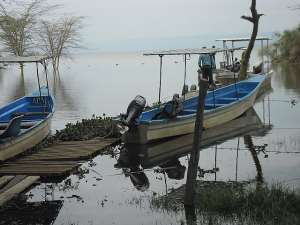
Water levels in Lake Naivasha are on the rise following the conservation efforts by various stakeholders around the lake to conserve it. Flower farms, fishermen and farmers at catchment areas are running joint restoration efforts aimed at limiting pollution and wastage of the lake's water.
Currently water levels are at 1889.57 meters and according to Craig Olton the production manager of Finlay Horticulture one of the horticultural companies engaged in the lake's restoration efforts. These water levels were witnessed in August 1998 during the El Nino rains. The government through boards is also backing the restoration efforts of these private commercial farming companies.
According Anderson Kogo the Executive Officer of the government's Imarisha Naivasha Board (INB), only by introducing sustainable environmental programs, can the lake support the high water demand flower, horticulture, tourism, fisheries, agriculture and pastoralist sectors there. One notable initiative recently introduced is the Papyrus Rehabilitation Project. The papyrus is being introduced in beaches around the lake and soon will be on the banks of Malewa River that flows into the lake.
The papyrus will purify the water naturally and offer an alternative income to communities around the lake. “If people have to look after something it must have revenue,” he said. The papyrus will be used by the communities for weaving mats as well as sustainable fuel source. “Sustainability is vital for everyone depending on the lake,” said Olton.
Already prototypes of a papyrus made charcoal have been produced, aimed as an alternative fuel source for communities instead of them cutting down trees. Papyrus is also fast growing and this ensure within 3 months stocks are replenished. A secondary use for the papyrus will be as a breeding area for fish and habitat for aquatic birds according Kogo. “This will enhance the biodiversity of the lake which draws more tourists to the lake,” he said.
To ensure even small holder farmers (SHFs) around the water catchment areas feel attached to the project they are paid for efforts they put in reducing soil erosion or planting trees through a Payment for Ecosystem Service (PES). The SHF conservation efforts have resulted in reducing silt flow into the lake and have been rewarded for it.
Last year 504 farmers were paid 8886 dollars through PES given out by Lake Naivasha Water Resource Users Association (LANAWRUA) which represents 23 commercial farms around the lake according to data by the Kenya Flower Council. The cash incentive has prompted other 618 farmers request for inclusion in the PES. Consequently more clean water from River Malewa is flowing into the lake.
In the past overreliance of the lake has also contributed to the dropping water levels. Now through the 400,000 $ INB got from the government, part of it has gone to construction of water pans and dams for pastoralists communities. Currently 20,000 pastoralists are benefitting from those pans and dams. Over 200,000 tree seedlings have also been planted in catchment by farming communities upstream.
These efforts according to Kogo will reduce water stress on the lake and horticulture farming companies around the lake are also engaged in water recycling when farming. “Creating this sustainable model is beneficial to around 600,000 people along the lake's basin depending it,” he said.




 Tuesday’s downpour destroys ceiling of Circuit Court '8' in Accra
Tuesday’s downpour destroys ceiling of Circuit Court '8' in Accra
 SOEs shouldn't compromise on ethical standards, accountability – Akufo-Addo
SOEs shouldn't compromise on ethical standards, accountability – Akufo-Addo
 Father of 2-year-old boy attacked by dog appeals for financial support
Father of 2-year-old boy attacked by dog appeals for financial support
 Jubilee House National Security Operative allegedly swindles businessman over sa...
Jubilee House National Security Operative allegedly swindles businessman over sa...
 Nobody can order dumsor timetable except Energy Minister – Osafo-Maafo
Nobody can order dumsor timetable except Energy Minister – Osafo-Maafo
 Mahama wishes National Chief Imam as he clock 105 years today
Mahama wishes National Chief Imam as he clock 105 years today
 J.B.Danquah Adu’s murder trial: Case adjourned to April 29
J.B.Danquah Adu’s murder trial: Case adjourned to April 29
 High Court issues arrest warrant for former MASLOC Boss
High Court issues arrest warrant for former MASLOC Boss
 Align academic curriculum with industry needs — Stanbic Bank Ghana CEO advocates
Align academic curriculum with industry needs — Stanbic Bank Ghana CEO advocates
 Election 2024: We'll declare the results and let Ghanaians know we've won - Manh...
Election 2024: We'll declare the results and let Ghanaians know we've won - Manh...
